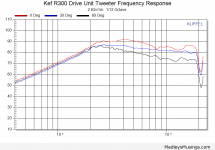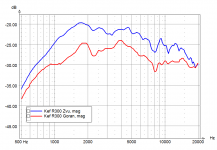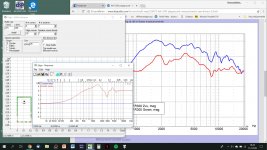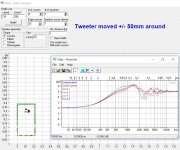I did some measurements of Kef R300 raw drivers. Rain prevented making full set of measurements but i found quiet enough neighbourhood so yesterday at about 01:00am some sweeps were heard from the parking lot.

https://s15.postimg.cc/5exyq4gu1/image.png

https://s15.postimg.cc/ivux8zyvd/image.png

https://s15.postimg.cc/8lsi9rgpl/image.png
This amount of quasi anechoic resolution makes it much easier to simulate the crossover between woofer and midrange.

https://s15.postimg.cc/y5cvgw7l5/image.png
I've managed to get about 9ms of gate time. I'm quite satisfied with consistency so here are files for simulators.
https://www.dropbox.com/s/dzg8gzfclgh8h92/Kef R300 sim files.zip?dl=0
Few words about it.
You'll find on axis and about 45deg off axis files in .zip folder. Only woofers are merged (between 100-200Hz). Mids and tweeters aren't because there's no need to. You have everything you need to derive Z axis offset. You'll find that frequency response of midrange+tweeter, that is needed to derive Z offset between them, drops bellow 300Hz. I am protecting the tweeter that way so, when deriving Z offset, look only how combined frequency response behaves above 300Hz in regard to reference. As far as X and Y offsets all you need to know is that woofer and midrange centers are 26cm apart. There are impedance files there. Just in case you don't like how i extracted my sim files i added HolmImpulse measurements .zip file that you can import into your HolmImpulse and set the gate to derive files as you see fit.
Here's Kef's crossover. I betcha you can do better than that if you try:

https://s15.postimg.cc/43flgo7hn/300.png
Measurements are done in factory cabinets, gated, at 1.03m distance mic at tweeter axis - gate is good to 100Hz. Holm-impulse, calibrated ECM8000, M-Audio Fast Track II USB interface, Dell Inspiron notebook.
Play and enjoy yourself

https://s15.postimg.cc/5exyq4gu1/image.png

https://s15.postimg.cc/ivux8zyvd/image.png

https://s15.postimg.cc/8lsi9rgpl/image.png
This amount of quasi anechoic resolution makes it much easier to simulate the crossover between woofer and midrange.

https://s15.postimg.cc/y5cvgw7l5/image.png
I've managed to get about 9ms of gate time. I'm quite satisfied with consistency so here are files for simulators.
https://www.dropbox.com/s/dzg8gzfclgh8h92/Kef R300 sim files.zip?dl=0
Few words about it.
You'll find on axis and about 45deg off axis files in .zip folder. Only woofers are merged (between 100-200Hz). Mids and tweeters aren't because there's no need to. You have everything you need to derive Z axis offset. You'll find that frequency response of midrange+tweeter, that is needed to derive Z offset between them, drops bellow 300Hz. I am protecting the tweeter that way so, when deriving Z offset, look only how combined frequency response behaves above 300Hz in regard to reference. As far as X and Y offsets all you need to know is that woofer and midrange centers are 26cm apart. There are impedance files there. Just in case you don't like how i extracted my sim files i added HolmImpulse measurements .zip file that you can import into your HolmImpulse and set the gate to derive files as you see fit.
Here's Kef's crossover. I betcha you can do better than that if you try:

https://s15.postimg.cc/43flgo7hn/300.png
Measurements are done in factory cabinets, gated, at 1.03m distance mic at tweeter axis - gate is good to 100Hz. Holm-impulse, calibrated ECM8000, M-Audio Fast Track II USB interface, Dell Inspiron notebook.
Play and enjoy yourself
Last edited:
Everything is in place - except the factory crossover, of course.
Medley's site can be reached through wayback machine but i don't find it representative because they are colapsed beyond any practical use. He did it with 10dB resolution with grid being about 90dB high. Mine are quite more revealing with 2dB resolution with grid height 40dB or less.
Medley's site can be reached through wayback machine but i don't find it representative because they are colapsed beyond any practical use. He did it with 10dB resolution with grid being about 90dB high. Mine are quite more revealing with 2dB resolution with grid height 40dB or less.
Last edited:
Thanks, I had mistakenly thought you were building DIY speakers rather than fixing the R300 crossover. I agree the Medley Musings measurements have less resolution than one would like. I think I might have been confusing them with the Soundstage measurements which have sufficient detail to see what is diffraction and what is not but, obviously, include the crossover and baffle. Look forward to seeing a full set of measurements.
Here are gornir's measurements of the R series coax in test baffle. Looks much better than in the the R300 box. www.audioexcite.com >> KEF SP1632
Also looks like the Q series is voiced differently, measured by AverageJoeAudiophile
Quick KEF Q100 1m measurements. On/Off axis & comparisons : audiophile
Anyway these KEF coaxes are pretty much the best you can get, then just fiddle with xo to suit your taste! Elac's Uni-Fi coax is obviously on-par and excellent value.
Also looks like the Q series is voiced differently, measured by AverageJoeAudiophile
Quick KEF Q100 1m measurements. On/Off axis & comparisons : audiophile
Anyway these KEF coaxes are pretty much the best you can get, then just fiddle with xo to suit your taste! Elac's Uni-Fi coax is obviously on-par and excellent value.
Here are gornir's measurements of the R series coax in test baffle. Looks much better than in the the R300 box. www.audioexcite.com >> KEF SP1632
I beg to differ. I think that Kef did much better job regarding diffraction than Goran with his test baffle, which is kinda expected given that he positioned R300 mid-hi on the center of the baffle. Problem is that low resolution on X axis and low resolution on Y axis (the way Goran showed his measurement) leads to wrong conclusions.
When i see 5dB or (worse) 10dB resolution on Y axis and i see, what i believe is, a problem - it always magnifies when i bring measurement resolution to what Geddes proposed: 2dB resolution with 40dB high Y axis grid.
Look how Goran's measurements look now...
Attachments
Last edited:
Thanks for the link to the measurements.Here are gornir's measurements of the R series coax in test baffle. Looks much better than in the the R300 box. www.audioexcite.com >> KEF SP1632
Also looks like the Q series is voiced differently, measured by AverageJoeAudiophile
Quick KEF Q100 1m measurements. On/Off axis & comparisons : audiophile
Anyway these KEF coaxes are pretty much the best you can get, then just fiddle with xo to suit your taste! Elac's Uni-Fi coax is obviously on-par and excellent value.
The Q series has a significantly different driver to the R series. The LS50 coaxial is derived from the R series but response between 1-5kHz is shaped significantly differently as can be seen here and here. A few years ago I auditioned the R300s but was disappointed with the sound and rather impulsively bought a pair of the drivers to see if I could do better flush mounting them into a false wall/cupboard after an imminent move to a new home. The move didn't happen and the drivers sat on a shelf.
Why do you believe the Elac unit is on par with the current KEF? They look more like SEAS/early KEF units from the pictures but I am happy to be persuaded otherwise.
Look how Goran's measurements look now...
Can I please check. Your measurements are using a sharp edged 210 x 385 mm KEF R300 baffle with woofer and Goran's are using a 229 x 559 mm baffle with a 12 mm radius?
Well I and I suppose may others are more accustomed to looking at scales with 5db grid. In your measurements we can see obvious baffle diffraction ripples at 8kHz and "positive effect" by baffle step around 1-2kHz.
Yes Q and R series use different units, and LS50 and Blade units are also different.
Elac UB speakers get nice reviews, like in here Elac Uni-Fi UB5 | The Absolute Sound
and here Elac Uni-Fi UB5 Speaker System Review Test Bench | Sound & Vision
and here ELAC UB5 Uni-fi Series Speakers
and here SoundStageNetwork.com | SoundStage.com - NRC Measurements: Elac Uni-Fi Slim FS U5 Loudspeakers
Elac UB5 has a little bump around 2kHz which is not totally compensated off-axis. But the the tweeter's response is very nice, which is often the most compromised in coaxials.
Andrew Jones has his fingerprints on both.
Yes Q and R series use different units, and LS50 and Blade units are also different.
Elac UB speakers get nice reviews, like in here Elac Uni-Fi UB5 | The Absolute Sound
and here Elac Uni-Fi UB5 Speaker System Review Test Bench | Sound & Vision
and here ELAC UB5 Uni-fi Series Speakers
and here SoundStageNetwork.com | SoundStage.com - NRC Measurements: Elac Uni-Fi Slim FS U5 Loudspeakers
Elac UB5 has a little bump around 2kHz which is not totally compensated off-axis. But the the tweeter's response is very nice, which is often the most compromised in coaxials.
Andrew Jones has his fingerprints on both.
Can I please check. Your measurements are using a sharp edged 210 x 385 mm KEF R300 baffle with woofer and Goran's are using a 229 x 559 mm baffle with a 12 mm radius?
I measured in factory cabinets. I didn't check what are baffle dimensions but if Kef website says it is 21x38.5cm then that's it. Göran stated his measurement conditions.
That would be a tiny baffle if the effect shows @ 8kHz.obvious baffle diffraction ripples at 8kHz and "positive effect" by baffle step around 1-2kHz.
Imo it is more likely that it is a speaker resonance.
That would be a tiny baffle if the effect shows @ 8kHz.
Imo it is more likely that it is a speaker resonance.
Dip at 8KHz is simptomatic (more or less) for most of the new UniQ drivers and is a product of tangerine phase plug diffraction. LS50 has it, R300/500/700/900 mid-hi has it, even Blade 2 has it but is somewhat masked and milder, which is understandable if we take the price into consideration. It vanishes completely off axis.
Last edited:
But there is vast difference in ripples 7-12kHz, from same driver. If it was just the tangerine plug, they would be identical - so I bet they come mostly from baffle edge interferences/diffractions. A shallow waveguide can't prevent them. All KEFs have quite the same baffle width. LS50 and Blade's baffles are curved which helps.
The midrange is not playing at all in these measurements!
The midrange is not playing at all in these measurements!
Attachments
Last edited:
There isn't a vast difference. Bare in mind that all measurements are done with different mics and equipment and most of the variations in mesurements happen bellow 150Hz and over 15KHz but can be under 15KHz very easy. There is also unit to unit difference due to different production batches. Wavelenght at 8KHz is arround 42mm and has nothing to do with baffle width. Remember how Kimmosto's measurement of the same UniQ were different when he ordered replacement driver for LS50.
An externally hosted image should be here but it was not working when we last tested it.
Last edited:
Thanks for the link to the measurements.
The Q series has a significantly different driver to the R series. The LS50 coaxial is derived from the R series but response between 1-5kHz is shaped significantly differently as can be seen here and here. A few years ago I auditioned the R300s but was disappointed with the sound and rather impulsively bought a pair of the drivers to see if I could do better flush mounting them into a false wall/cupboard after an imminent move to a new home. The move didn't happen and the drivers sat on a shelf.
Why do you believe the Elac unit is on par with the current KEF? They look more like SEAS/early KEF units from the pictures but I am happy to be persuaded otherwise.
I'm interested in buying KEF SP1632.
Sell me to them?
Of course. That's why i uploaded measurements at arround 45deg off axis. When ever i made sim for R300 crossover that was flat on axis, i got a bump at 2-3KHz off axis. So, little irregularities on axis is quite acceptable if the dips fills up off axis. Since it is a diffraction issue there's no need to try to solve it on axis.


Last edited:
If you can wait a few months they might become available. I have moved home a few weeks ago and the new living room is a modestly sized L shape and likely to be unsuitable for a wide beam width. Nonetheless I would first like to try the KEF coaxial in comparison with a narrower beam width mid/tweeter since I already have them. If things turn out as anticipated then they are likely to be surplus to requirements.I'm interested in buying KEF SP1632.
Sell me to them?
Back to UniQ vs UniFi, Polish site has measured two contenders in semi-budget 3-way floorstander category
KEF Q950 KEF Q950 - Zespoły głośnikowe | Testy w Audio.com.pl

Elac Uni-Fi FS U5 Slim ELAC UNI-FI FS U5 Slim - Zespoły głośnikowe | Testy w Audio.com.pl

And the winner is KEF! Coax unit is the larger one 17cm, R300 has 14cm. It looks like the Elac might benefit from some xo tweaks...
KEF Q950 KEF Q950 - Zespoły głośnikowe | Testy w Audio.com.pl

Elac Uni-Fi FS U5 Slim ELAC UNI-FI FS U5 Slim - Zespoły głośnikowe | Testy w Audio.com.pl

And the winner is KEF! Coax unit is the larger one 17cm, R300 has 14cm. It looks like the Elac might benefit from some xo tweaks...
- Home
- Loudspeakers
- Multi-Way
- KEF R300 playground - measurements of raw drivers



